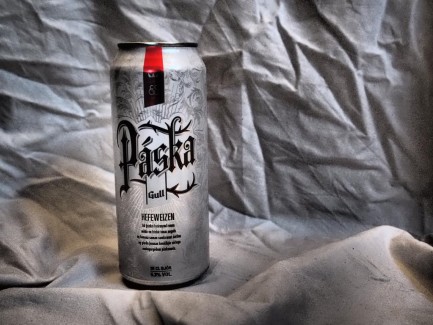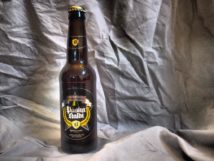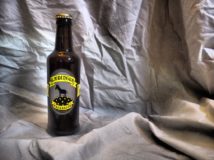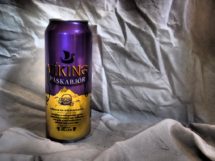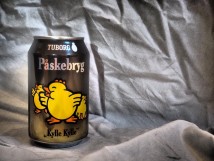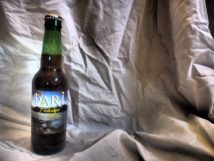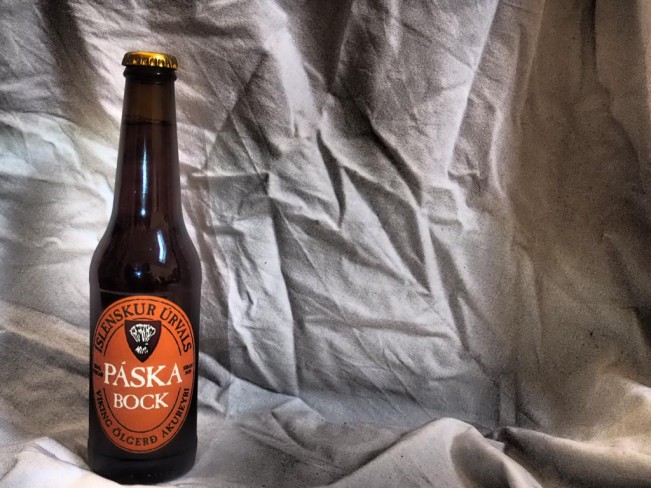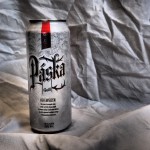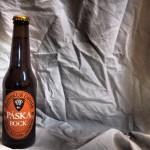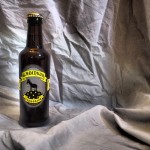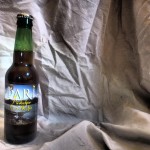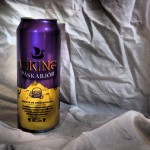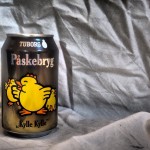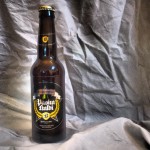For all English readers and all interested there is an English version below (it doesn’t exactly match the German version, it’s more a rating.)
“Andere Länder, andere Sitten”, denkt man, wenn man sich um die Osterzeit im isländischen Alkoholshop umsieht. Es gibt hier Osterbiere — und zwar ziemlich viele, mit ziemlich verrückten Zutaten. Dass es in einem Land mit 320 000 Einwohnern und kaum Anbaugebieten für Bierzutaten sechs Brauereien gibt, erstaunt, aber der Erfindungsreichtum beim Bierbrauen dann erst recht. Ich sage nur Walbier! Ein Bier, das Walhoden enthält, ja richtig, Hoden eines Finnwals! Warum? Das wissen wahrscheinlich nur die Erfinder. Es wurde zum isländischen Winterfest Þorrablót (Thorrablot) herausgebracht. Auch Weihnachtsbiere gibt es regelmäßig in den verschiedensten Varianten.
Aber zurück zum Osterbier.
Ich konnte 2015 sieben verschiedene Osterbiere ausmachen. Und es bleibt nicht dabei das Bier einfach Osterbier zu nennen und gut. Nein, der Bierproduzent Vífilfell (der auch einen Kakao herstellt), hat Kaffee, Karamell und Schokolade in sein Bier gemischt, die Brauerei Egill Skallagrímsson ließ sich dazu hinreißen, Bananen und Nelken ins Bier zu tun und konkurriert mit der Brauerei Steðji (die mit dem Walbier), um die eigenartigste Osterbiermischung. Diese hat nämlich ein Bier mit Algen und Kakao herausgebracht! Was das mit Ostern zu tu hat? Wohl nix. Aber witzig ist es.
Andere Brauereien waren weniger kreativ, wenn es um die Zutaten geht: Bruggsmiðjan braut sein Kaldi nach einem tschechischen Rezept und hat daran auch zu Ostern nichts geändert. Das dänische Tuborg hat lediglich ein Küken auf der Dose und auch die Brauerei Gæðingur hat ihrem niedlichen Logo mit Pferd nur ein paar österliche Blumen hinzugefügt.
Bei einer Verkostung mit Freunden stellte sich dann heraus, dass gerade diese Biere, ohne spezielle Zutaten, am besten schmecken. Das Algen-Kakao-Gemisch schmeckte nicht schlecht, stieß aber einigen etwas “fischig” oder “salzig” auf, Schokolade und Karamell ließen sich in Vífilfells Víking’s Páskabjór kaum herausschmecken, dafür konnte der Geschmack einer Mischung aus “kaltem Kaffee mit schlechtem Bier” (Zitat einer Freundin) nicht jeden auf Anhieb überzeugen. Am schlimmsten war aber das Bananen-Nelken-Bier, das nur Menschen mochten, die Gelee-Bananen lieben. Für alle anderen schmeckte es einfach nur nach etwas Verrottetem. Am geschmacklich besten schnitt dagegen das Kaldi ab, gefolgt von Tuborg.
Und was ist die Essenz aus alledem? Bier schmeckt ohne Zusätze von Algen und vor allem Bananen und Nelken wesentlich besser. Fürs Marketing sind diese verrückten Biere aber bestimmt sehr wertvoll. Und natürlich muss man alles mal probiert haben.
In diesem Sinne: Skál!
—
Easter Beers in Iceland: Which beer should we drink in our Easter holidays?
I am from Germany. We like beer. Generally we drink it pure, without any extra special ingredients, even on extra special holidays. That’s different in Iceland. Every holiday has its own beer which often contains weird things (like cloves or seaweed). As Easter is just around the corner a lot of Easter beers suddenly appeared in Vínbúðin. Seven to be exact. My eight friends and I bought all these seven beers and made a test.
Which beer should we drink during our Easter holidays? We took that important question seriously. With varying experience of beer drinking, the nine of us evaluated the beers with the following criteria in mind: taste, design, smell, look, cost effectiveness, its relation to Easter and finally we rated the beers’ overall impression on a scale from one to seven. This way we tried to find out which beer is actually drinkable and which should be not even looked at. All quotes below originate from the testing. Let’s start at the bottom and work our way upwards:
Páska from Gull brewery (average rating: 2,28) is in our last place. You don’t expect much when you read that a beer contains bananas and cloves. But when you taste this weird mix, your expectations, however low they are, are still not low enough. This beer could convince only someone who is obsessed with banana jelly candies. The general opinion was that this beer smells disgusting and tastes rotten.
A bock is not to everybody’s taste and that became obvious while tasting Víking’s Páska Bock (average rating: 2,5). The sweet malty taste didn’t impress. When it comes to cost effectiveness it is estimated that you can actually “get drunk before throwing up, but this seems to be much work”. The design is boringly described as “normal”.
Gæðingur’s Páskabjór (average rating: 2,71) we generally adjudged as bitter and its smell as fruity. Cost effectiveness is attested to be very low and some “rather stay sober” than drinking a lot of it. However its design convinced almost all of the testers, although the “cute horse” has obviously nothing to do with Easter.
The brewery Steðji decided to put cocoa and seaweed into its Þari Páskabjór (average rating: 2,75). Only they know how that is related to Easter. Generally it was described as a sweet, weird beer, that tasted a little bit “fishy”. Some liked it, some hated it. Although the majority liked the design (chiclets and landscape), one could not resist the impression that this beer looked like a “cheap book about love.” Cost effectiveness is estimated to be low.
The upper part of the ranking starts with Víking’s Páskabjór (average rating: 2,96). Smelling “fruity, nice and fresh” the beer should contain chocolate, coffee and caramel according to the label. The chocolate-caramel flavour could not be smacked while the taste of “cold coffee and bad beer” didn’t convince everyone. Besides that, the can’s colour combination, violet and yellow, made some of our eyes hurt.
Tuborg’s Påskebryg ”Kylle Kylle” made the second place (average rating: 4,02). Although its taste was characterised as “normal” and “boring” it left the before mentioned beers in the dust. Maybe it convinced with its Eastery design: A chiclet is decorating the can and let it look like a “beverage for kids”. Don’t confound it!
And the winner is: Páska Kaldi from Bruggsmiðjan (average rating: 4,54). It convinces with a “sweet but not too sweet” taste and a “good design.” Furthermore “you can easily get drunk” with this beer, so cost effectiveness is estimated to be high.
Finally our conclusion is that the beers without extra special flavours are still the best ones and Páska Kaldi is our number one recommendation for Easter! Skál!
—
Criteria:
Taste: How does the beer taste? Sour, sweet, alcoholic, bitter? Level of sparkling?
Look of the bottle/beer can and the Logo: Does it look funny? Easter‑y? Eggy? What about the logo? Is nice/awful/ humorous?
Smell: Does it smell? How? Does it smell when you move the glass? How? Eggy? Disgusting?
Look of the beer: What does the beer look like? Criteria: Bright, colour, froth.
Cost Effectiveness: What do you get? How drunk can you get for your money and before puking?
Relation to Easter?: Is there any? What do you think is the relation? Your thoughts.
Overall impression: Your final rating, what can you say about this beer? And Score.
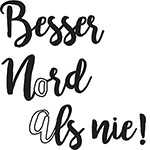
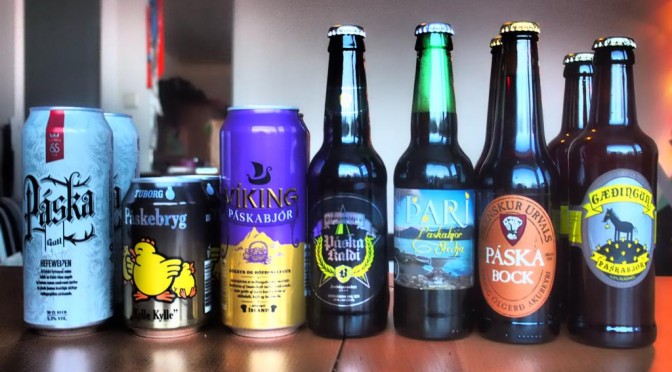 Foto: Besser Nord als nie!
Foto: Besser Nord als nie! 